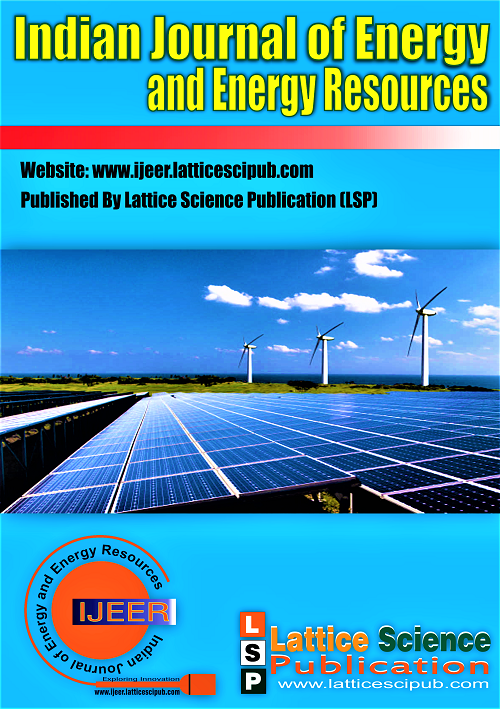Time Series Forecasting Analysis for Automated Smart Meter Reading System
Main Article Content
Abstract
The Smart Meter Reading System modernizes traditional meter reading by enabling real-time energy monitoring and short-term consumption predictions for sectors like banking and automotive. The research in this paper focuses on the comparative application of time series forecasting techniques for enhancing the performance of Automated Smart Meter Reading(AMR) Systems. With a growing need for efficient energy management, especially in the context of smart grids and real-time analysis, this study explores how advanced machine learning and deep learning models can predict electricity energy consumption based on smart meter data. The research uses a realworld dataset from the UCI Machine Learning Repository: https://archive.ics.uci.edu/dataset/290/tamilnadu+electricity+boar d+hourly+readings. The study leverages time series forecasting models, including ARIMA, SARIMA, SARIMAX, LSTM, XGBoost, and CATBoost, to capture trends, seasonality, and long-term dependencies in sequential data. Each model is evaluated on benchmark metrics such as Root Mean Squared Error( RMSE) and Mean Squared Error (MSE) to measure forecasting accuracy. We have observed that the best models for our purpose of short-term predictions are our two ensemble models. We also find XGBoost to have significantly high predictive reliability. Traditional models like ARIMA have not produced adequate results for the energy data. This study is significant as it demonstrates that integrating machine learning and deep learning into AMR systems enhances the intelligence and responsiveness of the overall system. Accurate forecasting allows utilities to make informed decisions, optimize grid load, and foster consumer awareness. The findings advocate for adopting advanced data-driven methods in modern energy infrastructures to promote efficiency, reliability, and sustainability.
Downloads
Article Details

This work is licensed under a Creative Commons Attribution-NonCommercial-NoDerivatives 4.0 International License.
How to Cite
References
B. Lim and S. Zohren, “Time-series forecasting with deep learning: a survey,” Philos. Trans. A Math. Phys. Eng. Sci., vol. 379, no. 2194, 2021, Art. no. 20200209. DOI: http://doi.org/10.1098/rsta.2020.0209
Z. Chen, M. Ma, T. Li, H. Wang, and C. Li, “Long sequence time-series forecasting with deep learning: A survey,” Inf. Fusion, vol. 97, pp. 101819, 2023. DOI: http://doi.org/10.1016/j.inffus.2023.101819
E. S. Gardner Jr., “Exponential smoothing: The state of the art,” J. Forecast., vol. 4, no. 1, pp. 1–28, 1985. DOI: http://doi.org/10.1002/for.3980040103
A. Sagheer and M. Kotb, “Time series forecasting of petroleum production using deep LSTM recurrent networks,” Neurocomputing, vol. 323, pp. 203–213, 2019. DOI: http://doi.org/10.1016/j.neucom.2018.09.082
X. Cui, “A time series forecasting model based on machine learning,” in Proc. IEEE Int. Conf. Power Intell. Comput. Syst. (ICPICS), 2024, vol. 6, pp. 226–230. DOI: http://doi.org/10.1109/ICPICS62053.2024.10796427
L. Zhang, W. Bian, W. Qu, L. Tuo, and Y. Wang, “Time series forecast of sales volume based on XGBoost,” J. Phys. Conf. Ser., vol. 1873, no. 1, p. 012067, 2021. DOI: http://doi.org/10.1088/1742-6596/1873/1/012067
R. P. Masini, M. C. Medeiros, and E. F. Mendes, “Machine learning advances for time series forecasting,” J. Econ. Surv., vol. 35, no. 5, pp. 1–26, 2021. DOI: http://doi.org/10.1111/joes.12429
S. Mehrmolaei and M. R. Keyvanpour, “Time series forecasting using improved ARIMA,” in Proc. Artif. Intell. Robot (IRANOPEN), 2016, pp. 92–97. DOI: http://doi.org/10.1109/RIOS.2016.7529496
S. Palaniappan, R. Asokan, S. Bharathwaj, and S. N. Sujaudeen, “Automated Meter Reading System - A Study,” Int. J. Comput. Appl., 2015. DOI: http://doi.org/10.5120/20440-2783
S. Kamolov, D. I. Dilshod, and B. Ziyaev, “Machine learning methods in time series forecasting: a review,” Ann. Math. Comput. Sci., vol. 2, pp. 10–14, 2021. DOI: http://doi.org/10.56947/amcs.v2.13
P. T. Yamak, L. Yujian, and P. K. Gadosey, “A comparison between ARIMA, LSTM, and GRU for time series forecasting,” in Proc. Int. Conf. Algorithms Comput. Artif. Intell. (ACAI), 2019, vol. 2, pp. 49–55. DOI: http://doi.org/10.1145/3377713.3377722
D. M. Xue and Z. Q. Hua, “ARIMA-based time series forecasting model,” Recent Adv. Electr. Electron. Eng., vol. 9, no. 2, pp. 93–98, 2016. DOI: http://doi.org/10.2174/2352096509999160819164242
P. Chen, A. Niu, D. Liu, W. Jiang, and B. Ma, “Time series forecasting of temperatures using SARIMA: an example from Nanjing,” IOP Conf. Ser. Mater. Sci. Eng., vol. 394, no. 5, p. 052024, 2018. DOI: http://doi.org/10.1088/1757-899X/394/5/052024
I. Paliari, A. Karanikola, and S. Kotsiantis, “A comparison of the optimized LSTM, XGBOOST, and ARIMA in time series forecasting,” in Proc. Int. Conf. Inf. Intell. Syst. Appl. (IISA), 2021, vol. 12, pp. 1–7. DOI: http://doi.org/10.1109/IISA52424.2021.9555520
R. Gupta, A. K. Yadav, S. Jha, and P. K. Pathak, “Time series forecasting of solar power generation using Facebook Prophet and XG Boost,” in Proc. IEEE Delhi Sect. Conf. (DELCON), 2022, pp. 1–5. DOI: http://doi.org/10.1109/DELCON54057.2022.9752916
J. M. Ahn, J. Kim, and K. Kim, “Ensemble machine learning of gradient boosting (XGBoost, LightGBM, CatBoost) and attention-based CNN-LSTM for harmful algal blooms forecasting,” Toxins (Basel), vol. 15, no. 10, p. 608, 2023. DOI: http://doi.org/10.3390/toxins15100608
F. Zhang, H. Fleyeh, and C. Bales, “A hybrid model based on bidirectional long short-term memory neural network and Catboost for short-term electricity spot price forecasting,” J. Oper. Res. Soc., vol. 73, no. 2, pp. 301–325, 2020. DOI: http://doi.org/10.1080/01605682.2020.1843976
V. V. Vineeth, V. Ambrish, D. V. Haricharann, V. Harshini, and C. Abilash, “Power theft recognition and data security in smart meter reading of a smart grid,” J. Phys. Conf. Ser., vol. 1916, no. 1, p. 012216, 2021. DOI: http://doi.org/10.1088/1742-6596/1916/1/012216
Sharma, T., & Sharma, R. (2024). Smart Grid Monitoring: Enhancing Reliability and Efficiency in Energy Distribution. Indian Journal of Data Communication and Networking, 4(2), 1–4. DOI: https://doi.org/10.54105/ijdcn.d7954.04020224
Chowdhury, S., & Sen, S. K. (2020). Security in Smart Meter using Iot. International Journal of Engineering and Advanced Technology, 9(4), 2293–2295. DOI: https://doi.org/10.35940/ijeat.d9087.049420
Asundi, A. K., Jyoti, P. B., Nagaraj, M. S., & Sultan, S. S. (2019). An Efficient Cryptography Key Management for Secure Communications in Smart Metering. International Journal of Innovative Technology and Exploring Engineering, 8(10), 2908–2916. DOI: https://doi.org/10.35940/ijitee.i7846.0881019
Paul, D., Pal, O. K., Islam, Md. M., Mohammad, M., & Babu, R. M. (2023). Design and Implementation of an Efficient Smart Digital Energy Meter. International Journal of Soft Computing and Engineering, 13(1), 25–30. DOI: https://doi.org/10.35940/ijsce.a3600.0313123
Gupta, S. K. (2022). Smart Grid System in India. Indian Journal of Energy and Energy Resources, 1(4), 5–6. DOI: https://doi.org/10.54105/ijeer.c1018.081422





